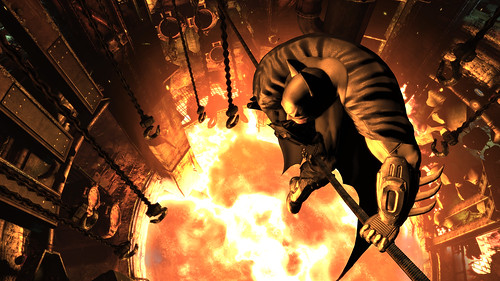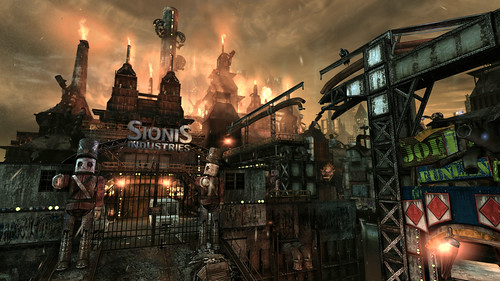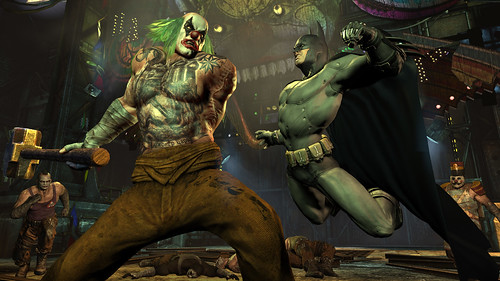My flatmate cites Arkham Asylum as his favorite game, and when I got home and told him that I’d been to see it at Warner Bros. London office, he put his fingers in his ears and turned the stereo up. It confirmed something I’d been thinking on the train home: this is one of those games that we’re better off not knowing much about.

There’s five of us in the private screening room and Dax Ginn, marketing game manager at Rocksteady, has just played through an early mission from Arkham City, lasting around 30 minutes, which I’m not going to spoil for you. We are free to call out questions afterwards and one journalist asks, “Will we see anything like the Scarecrow missions from Arkham Asylum?”
“Did you like the scarecrow stuff?” he replies to slow nods. “Well we did too. Aren’t you glad that you didn’t know about the Scarecrow levels before you played Arkham Asylum? If they had been part of the marketing campaign they wouldn’t have had that kind of impact, so I’m just going to leave it there.”
The biggest difference between Arkham City and its predecessor is the move to a more open setting. In the intervening 18 months, Quincy Sharp, who was the warden of the Asylum, is elected Mayor of Gotham and transfers all of the inmates to Arkham City. Batman has been watching all of this happen and he knows that he’s going to have to deal with it.
Arkham City is also around five times bigger than the Asylum and most of it is open to the player from the start.” Anything that is open to the sky is open to player right from the off,” Dax explains. “Nobody tells Batman where to go so it was important for us to give that freedom right at the start. The interiors are gated and will open as a result of narrative progression.”

“Our attitude towards pacing is to throw everything at the player straight away and let them decide how and when they want to navigate those options. Telling a story in Arkham Asylum was very easy because it was a very linear experience. Arkham City isn’t a sandbox game but it’s not completely linear either – it’s somewhere in-between.”
“What we don’t want to do was ruin the pacing with frivolous collection missions where you have to go and find 50 things while Gotham is burning – Batman wouldn’t do that. We have a tight core narrative with clear paths; going off-piste inevitably yields other options but they are always character driven, whether that’s answering a phonecall from Zsasz and having him taunt you or finding an informant who reveals another snippet of information.”
Batman is able to negotiate this large, open space by gliding and swooping to gain momentum, using his Bat Claw to catch the corners of buildings and propel himself skyward. He can even hook onto patrol helicopters and perch on the landing gear as chaos unfolds beneath.
“If you’re just flying around the streets looking for a fight,” Dax adds, “you’ll pick up bits of information that have been designed to be communicated in an ambient fashion at that particular stage in the game. There is a vast amount of conversational dialogue that has been a serious job to write and record, but we finally finished it last Wednesday.”

“We’re constantly looking at Arkham Asylum and seeing how it feeds into Arkham City. The same applies to characters, combat, moves; they all carry over but how they have evolved is directly related to the new challenges Batman is facing.”
This also applies to Detective Mode, an X-ray overlay that you use to gather forensic information. Some people had mixed feelings about it because, while it was very useful, they felt like they were missing out the game’s incredible visuals by using it.
“There weren’t a lot of criticisms of Arkham Asylum but that was one of them,” says Dax, “and thinking about why people reacted the way that they did and what we’re going to do about it was really interesting. Batman is a detective, so removing detective mode wasn’t an option for us because it suits him so well and it allows us to do these slower paced investigation sections.”
“Our thinking was more about why people responded to it in that way. Gamers wanted it to be more of a tool, just like the Bat Claw is a tool. We hadn’t balanced it right so it felt more like an exploit than a tool, because it gave you so much information. That’s our understanding of the criticisms and our response has been to balance that information better.”
Before we finished, one journalist enquired if Rocksteady would be interested in working on a game adaptation of The Dark Knight Rises.
“He [Christopher Nolan] is a pretty amazing guy and that would be a brilliant lunchtime meeting to have, discussing how that might work. But what we find with the comic book license is that we get creative freedom to push the characters in pretty much any direction we like; we’re not bound to a single narrative. I’m not saying we’ll never make a game based on a movie, but as of right now and from a creative perspective, it’s not something we want to be doing.”
Arkham City is looking very much the worthy successor to my flatmate’s favorite PS3 game. From the sound of it, we can expect plenty of surprises when it is released, and I can promise you won’t read about them here first.
